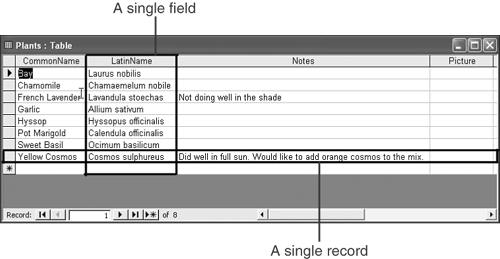Absolute Beginner's Guide to MicrosoftR Access 2002
What's in a Table?
You learned about some of the basic parts of a table in Chapter 4, "Planning a Database." But before you actually build a table, you should review the three basic components one more time:
Note
Fields
A field is the smallest unit of data in the database. In the plants database, some of the fields are CommonName, LatinName, StreetAddress, and City. Each thing you store in the database is described by one or more fields. As part of the process of designing tables, you'll tell Access which fields belong in each table. Records
When you fill in all the fields in a table, you're creating a record . A table might contain no records at all (if you haven't entered any data yet), or it might contain hundreds, thousands, or even millions of records. In the plants database, for example, each individual plant is the subject of one record. You can't enter records in a table before you have defined the fields for that tableuntil then, there's no place to enter the data! Figure 5.1 shows the connection between fields, records, and tables. Figure 5.1. Fields and records in a table.
Primary Key
The other thing to keep in mind when building tables is that each table should have a primary key. A primary key , you'll recall, is the field (or group of fields) that uniquely identifies each record in a table. A bit later in the chapter you'll learn how to tell Access which field in your table contains the primary key.
Tip
|


